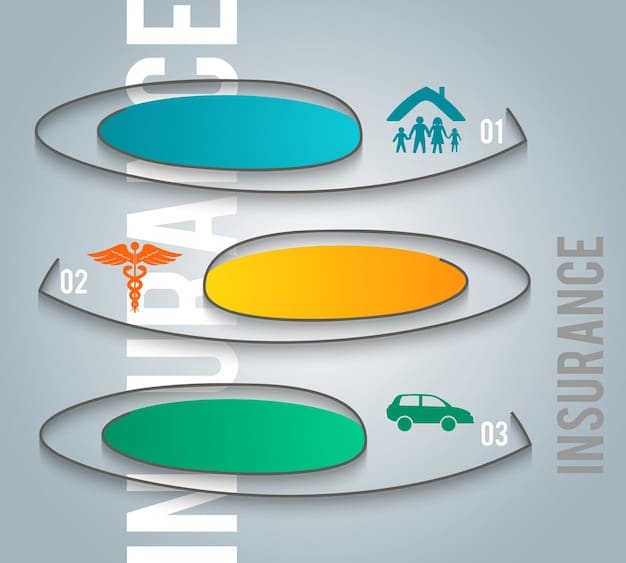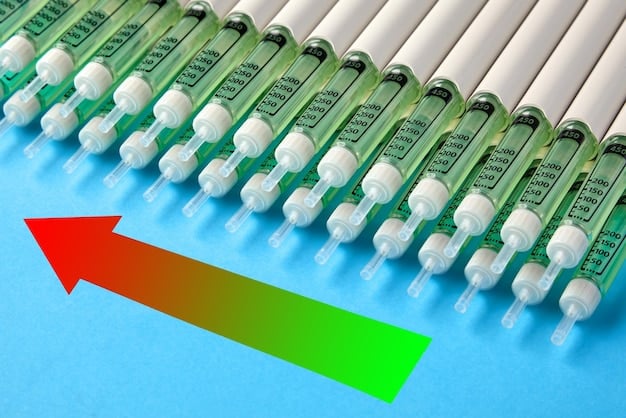Medicare Part D Changes for 2025: A Comprehensive Guide

Understanding the New Changes to Medicare Part D: What You Need to Know for 2025 involves significant adjustments to prescription drug coverage, aiming to lower costs and improve access for beneficiaries, effective January 1, 2025, impacting premiums, cost-sharing, and covered medications.
Navigating the complexities of Medicare can be daunting, especially when changes are on the horizon. Understanding the New Changes to Medicare Part D: What You Need to Know for 2025 is crucial for beneficiaries to prepare for adjustments that will impact their prescription drug coverage and overall healthcare expenses. Let’s delve into what these changes entail and how they may affect you.
Overview of Medicare Part D
Medicare Part D is the federal government program that subsidizes the costs of prescription drugs for Medicare beneficiaries. It’s an optional benefit, but enrolling can significantly reduce out-of-pocket expenses for medications. Understanding its basic components is the first step to grasping the upcoming changes.
Part D plans are offered by private companies that have been approved by Medicare. Each plan has its own formulary (list of covered drugs), premiums, and cost-sharing structure.
Key Components of Medicare Part D
To fully understand the changes coming in 2025, it’s helpful to review the four phases of Medicare Part D coverage:
- Deductible: The amount you pay out-of-pocket before your plan starts to pay.
- Initial Coverage: After meeting your deductible, you share the cost of your drugs with your plan.
- Coverage Gap (Donut Hole): A temporary limit on what the drug plan will cover. In 2024, you pay 25% of the cost for covered brand-name and generic drugs while in the coverage gap.
- Catastrophic Coverage: After you’ve spent a certain amount out-of-pocket, you enter catastrophic coverage, where you pay a small coinsurance or copayment for covered drugs for the rest of the year.
Understanding these phases sets the stage for understanding how the new changes in 2025 will alter the landscape of Medicare Part D.

Major Changes Coming to Part D in 2025
Several significant changes are set to take effect in Medicare Part D in 2025, stemming from the Inflation Reduction Act of 2022. These changes are designed to lower drug costs and improve access to medications for Medicare beneficiaries.
The most impactful changes revolve around the coverage gap, cost-sharing, and the introduction of a new maximum out-of-pocket expense.
Elimination of the Coverage Gap
One of the most significant changes is the elimination of the coverage gap, also known as the “donut hole”. In previous years, beneficiaries would enter a phase where they were responsible for a larger portion of their drug costs. The Inflation Reduction Act eliminates this gap, providing more consistent coverage throughout the year.
This means that beneficiaries will no longer experience a temporary increase in their prescription drug costs after reaching a certain spending threshold. Instead, cost-sharing will remain more consistent throughout the year, providing greater financial stability.
Capping Out-of-Pocket Costs
Another major change is the establishment of a hard cap on out-of-pocket prescription drug costs. Starting in 2025, Medicare beneficiaries will not have to pay more than \$2,000 out-of-pocket for their covered prescription drugs each year.
This cap is a significant benefit for beneficiaries with high drug costs, as it provides a predictable limit on their annual expenses. Once the cap is reached, Medicare will cover 100% of the remaining costs for covered drugs.

Impact on Premiums and Cost-Sharing
The changes to Medicare Part D in 2025 will also affect premiums and cost-sharing structures. While some premiums may increase slightly, the overall cost savings from the elimination of the coverage gap and the out-of-pocket cap are expected to outweigh any premium increases for many beneficiaries.
Cost-sharing arrangements will also be adjusted, with a greater emphasis on providing affordable access to medications throughout the year.
Changes to Cost-Sharing
With the elimination of the coverage gap, cost-sharing will become more predictable. Beneficiaries will generally pay a set percentage or copayment for their drugs, regardless of how much they’ve already spent during the year. This simplifies the cost structure and makes it easier to budget for medication expenses.
- Lower and predictable cost-sharing throughout the year.
- No sudden increases in drug costs due to the coverage gap.
- Greater financial stability for beneficiaries with chronic conditions.
These changes are designed to make prescription drugs more affordable and accessible for all Medicare beneficiaries, regardless of their income or health status.
How to Prepare for the 2025 Changes
Preparing for the Medicare Part D changes in 2025 involves several steps. Beneficiaries should review their current plan, understand the new cost structure, and explore options for minimizing their drug costs.
It’s also important to stay informed about the changes and seek assistance from trusted sources if needed.
Review Your Current Plan
The first step is to review your current Medicare Part D plan. Understand your formulary, premiums, and cost-sharing structure. Pay attention to any notices from your plan about changes for the upcoming year.
Consider whether your current plan will still meet your needs in 2025, given the new changes. If not, explore other options during the open enrollment period.
Explore Other Plan Options
Medicare’s open enrollment period, which typically runs from October 15 to December 7, is the ideal time to explore other Part D plan options. Use the Medicare Plan Finder tool on the Medicare website to compare plans and find one that best suits your needs and budget.
Consider factors such as the formulary, premiums, cost-sharing, and pharmacy network when comparing plans. Choose a plan that covers your medications at an affordable price.
Resources for Additional Information
Navigating the changes to Medicare Part D can be complex. Fortunately, several resources are available to provide additional information and assistance.
These resources include the Medicare website, State Health Insurance Assistance Programs (SHIPs), and advocacy organizations.
- Medicare Website: The official Medicare website (medicare.gov) is a comprehensive resource for information about Medicare Part D and the upcoming changes.
- State Health Insurance Assistance Programs (SHIPs): SHIPs are state-based programs that provide free, unbiased counseling to Medicare beneficiaries.
- Advocacy Organizations: Several advocacy organizations, such as the National Council on Aging (NCOA) and the Medicare Rights Center, offer information and assistance to Medicare beneficiaries.
By utilizing these resources, beneficiaries can stay informed about the changes to Medicare Part D and make informed decisions about their healthcare coverage. These resources can help make the process easier to understand.
The Future of Medicare Part D
The 2025 changes to Medicare Part D are a significant step towards making prescription drugs more affordable and accessible for Medicare beneficiaries. However, the future of Medicare Part D is likely to involve ongoing adjustments and reforms.
These reforms may address issues such as drug pricing, formulary design, and the role of pharmacy benefit managers (PBMs). The goal is to ensure that Medicare Part D continues to meet the needs of beneficiaries while promoting value and sustainability.
Potential Future Changes
Looking ahead, potential future changes to Medicare Part D could include:
- Negotiating drug prices: Allowing Medicare to negotiate drug prices could significantly lower costs for beneficiaries.
- Reforming PBM practices: Implementing reforms to address the role of PBMs in drug pricing and formulary design could promote transparency and efficiency.
- Expanding coverage: Expanding coverage to include additional preventive services and treatments could improve health outcomes for beneficiaries.
These changes will ultimately shape the future of Medicare Part D and its impact on the healthcare of millions of Americans. Keeping abreast of these potential changes can help you adapt to new legislation and regulations.
| Key Highlights | Brief Description |
|---|---|
| ✅ Coverage Gap Elimination | Coverage gap (“donut hole”) is eliminated, providing consistent coverage. |
| 💰 Out-of-Pocket Cap | A \$2,000 cap on annual out-of-pocket prescription drug costs. |
| 📑 Plan Review | Beneficiaries should review their current plan and explore new options. |
| ℹ️ Additional Resources | Medicare website and SHIPs offer valuable assistance. |
Frequently Asked Questions (FAQ)
▼
The coverage gap, or “donut hole,” was a phase in Medicare Part D where beneficiaries paid a higher portion of their drug costs. This gap is eliminated in 2025, providing more consistent coverage throughout the year.
▼
Starting in 2025, once your out-of-pocket spending on covered prescription drugs reaches \$2,000, Medicare will cover 100% of your remaining drug costs for the rest of the year.
▼
Some premiums may increase slightly, but many beneficiaries are expected to see overall cost savings due to the elimination of the coverage gap and the out-of-pocket cap. Review your plan’s details.
▼
The Medicare open enrollment period, from October 15 to December 7, is the time to review your plan options and make changes for the upcoming year. Use Medicare’s Plan Finder tool.
▼
You can get help from the Medicare website, State Health Insurance Assistance Programs (SHIPs), and advocacy organizations like the National Council on Aging and the Medicare Rights Center.
Conclusion
Understanding the New Changes to Medicare Part D: What You Need to Know for 2025 is essential for all beneficiaries. With the elimination of the coverage gap and the establishment of an out-of-pocket cap, the changes aim to provide more affordable and predictable access to prescription drugs. By staying informed and reviewing your plan options, you can ensure that you are well-prepared for these changes and can make the best choices for your healthcare needs. It is beneficial to explore all available resources and information to assist with this process.





